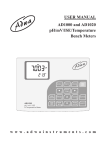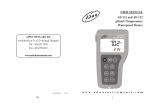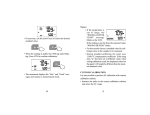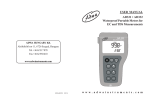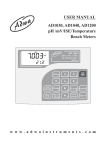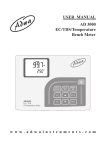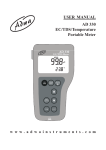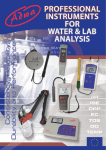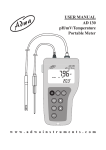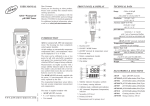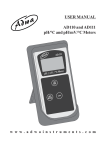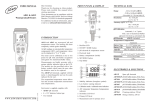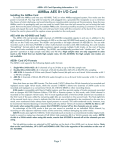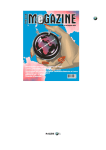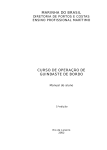Download USER MANUAL AD8000 pH/mV/EC/TDS/Temperature Bench Meter
Transcript
USER MANUAL AD8000 pH/mV/EC/TDS/Temperature Bench Meter w w w . a d w a i n s t r u m e n t s . c o m 1 Dear Customer, Thank you for choosing an Adwa product. Please read carefully this manual before starting operations. This instrument is in compliance with the EMC directive 2004/108/EC and its standards, and Low Voltage Directive 2006/95/EC and its standards for electrical equipments. For additional technical information, please e-mail us at [email protected]. 2 TABLE OF CONTENTS Introduction ............................................................... 4 Technical Data .......................................................... 6 Front and Rear Panels ............................................... 8 Operational Guide ................................................... 10 Autoranging ............................................................. 20 pH Calibration ......................................................... 21 Relative mV Calibration ......................................... 28 EC Calibration ......................................................... 29 Good Laboratory Practice ....................................... 34 Setup ........................................................................ 44 Hold Function .......................................................... 50 Probe Maintenance .................................................. 51 Troubleshooting Guide ........................................... 54 Electrodes, Probes and Solutions ........................... 56 3 INTRODUCTION AD8000 is a microprocessor-based pH, ORP, conductivity, TDS and temperature bench meter. Relative mV feature is also provided. The autoranging feature of the EC and TDS ranges automatically sets the instrument to the scale with the highest resolution. pH measurements are compensated for temperature effect automatically (ATC) using AD7662 temperature probe, while the EC readings can be compensated automatically (ATC) using the conductivity probe with builtin temperature sensor or manually (MTC). It is also possible to disable the temperature compensation and measure the actual conductivity. The temperature coefficient is user selectable. The pH calibration can be performed at 1, 2 or 3 points with five memorized buffers (pH 4.01, 6.86, 7.01, 9.18, 10.01). In addition, AD8000 is provided with calibration timeout alarm, GLP feature to view last calibration data and automatic HOLD feature to freeze the first stable reading on the LCD. 4 This model is supplied complete with: • AD1131B refillable pH electrode with glass body, BNC connector and 1 m cable • AD76309 conductivity probe with built-in temperature sensor and 1 m cable • AD7662 stainless steel temperature probe, 1 m cable • pH 4.01 and pH 7.01 calibration buffers (20 ml sachet each) • EC calibration solutions at 1413 μS/cm and 12.88 mS/ cm (20 ml sachet each) • 12 Vdc power adapter • User manual 5 TECHNICAL DATA Range -2.00 to 16.00 pH /-2.000 to 16.000 pH ±699.9 mV / ±2000 mV 0.00 to 19.99 μS/cm; 0.00 to 9.99 ppm 20.0 to 199.9 μS/ cm; 10.0 to 99.9 ppm 200 to 1999 μS/cm; 100 to 999 ppm 2.00 to 19.99 mS/cm; 1.00 to 9.99 ppt 20.0 to 199.9 mS/cm; 10.0 to 99.9 ppt -9.9 to 120.0°C (pH range) 0.0 to 100.0°C (EC range) Resolution 0.01 pH / 0.001 pH 0.1 mV (±699.9 mV) / 1 mV (±2000 mV) 0.01, 0.1, 1 μS/cm; ppm 0.01, 0.1 mS/cm; ppt 0.1°C Accuracy ± 0.01 pH / ± 0.002 pH (@25°C) ± 0.2 mV up to ± 699.9 mV ± 1 mV up to ± 2000 mV ± 1% f.s. (EC/TDS) ± 0.5°C Relative mV offset range ± 2000 mV 6 pH Calibration Up to 3-point calibration, 5 buffer available (4.01, 6.86, 7.01, 9.18, 10.01 pH) EC Calibration Offset at 0.00 μS/cm; Slope at 1 point with 6 memorized values (84.0, 1413 μS/cm; 5.00, 12.88, 80.0, 111.8 mS/cm) or with custom value Temperature Automatic or manual Compensation -9.9 to 120.0°C (pH range) 0.0 to 100.0°C (EC range) Temperature 0.00 to 10.00%/°C Coefficient (EC) (default: 1.90%/°C) TDS Factor Selectable from 0.40 to 1.00 (default value: 0.50) pH electrode AD1131B EC probe AD76309 with built-in temperature sensor Power supply 12 Vdc power adapter Dimensions 230 x 180 x 50 mm Weight 1.8 kg Environment 0 to 50°C RH max. 95% non-condensing 7 FRONT AND REAR PANELS Front Panel Rear Panel 8 1. 2. 3. 4. 5. Liquid Crystal Display (LCD) SETUP key, to enter/exit setup mode CFM key, to confirm values CAL key, to enter/exit calibration mode Up arrow key, to manually increase the value of temperature or other parameters 6. Down arrow key, to manually decrease the value of temperature or other parameters 7. SHIFT key, to activate the key alternate function (press and hold first the SHIFT key and then the second desired key) 8. “lock” key, to freeze current EC range on the LCD or to clear pH calibration parameter 9. RANGE/MODE key, to select measurement unit or switch the focused data and to select measurement mode or pH resolution 10. ON/OFF key, to turn the instrument ON and OFF 11. HOLD/GLP key, to freeze the first stable reading on the LCD and to display GLP information 12. Power supply socket 13. Conductivity probe connector 14. Reference input socket 15. BNC connector for pH or ORP electrode 16. Temperature probe socket 9 OPERATIONAL GUIDE CONNECTIONS • Plug the 12 Vdc adapter into the power supply socket. Note: This instrument uses non volatile memory to retain the calibration parameters and all other settings even when unplugged. • For pH or ORP measurements, connect the electrode to the BNC connector. For electrodes with separate reference, connect the reference electrode plug to the reference socket. • For temperature measurements and automatic temperature compensation, connect the temperature probe to the appropriate socket. • For EC and TDS measurements, connect the probe to the 7-pin connector. Tighten the threaded ring and make sure the probe sleeve is properly inserted. 10 INSTRUMENT START-UP • Turn the instrument on by pressing the ON/OFF button. • All LCD tags are displayed and a beep is generated while the instrument performs a self test. Notes: • The instrument starts in the same range and mode as it was at power off. • The RANGE key toggles between pH, mV and EC ranges. • The SHIFT and MODE keys change the displayed information for the selected range. 11 pH MEASUREMENTS Make sure the instrument has been calibrated before taking pH measurements. • Press RANGE to enter pH range. Note: To change pH resolution press and hold first SHIFT and then MODE key. • Immerse the electrode tip and the temperature probe approximately 4 cm into the sample to be tested and stir gently. Allow for the reading to stabilize. • The pH value is displayed on the primary LCD and the temperature on the secondary LCD. • If the pH reading is out of range, the closest full-scale value will blink on the primary LCD. 12 • If measurements are taken successively in different samples, it is recommended to rinse the electrode thoroughly with deionized or tap water and then with some of the next sample. • The pH reading is affected by temperature. In order to measure the pH accurately, the temperature effect must be compensated for. To use the ATC (Automatic Temperature Compensation) capability of the instrument, connect the AD7662 temperature probe, immerse it into the sample as close as possible to the pH electrode and wait for a few seconds. • If the solution temperature is known, MTC (Manual Temperature Compensation) can be performed by disconnecting the temperature probe. The display will show the default temperature of 25°C or the last temperature reading with the °C tag blinking. • The temperature can be adjusted using the arrow keys (from -9.9°C to 120.0°C). 13 ORP (mV) MEASUREMENTS Oxidation-Reduction Potential (ORP) measurements provide the quantification of the oxidizing or reducing power of the tested sample. To correctly perform a redox measurement, the surface of the ORP electrode must be clean and smooth. • Press RANGE to enter mV range. • Immerse the tip of the ORP electrode 4 cm into the sample to be tested and allow a few seconds for the reading to stabilize. • The instrument displays the mV reading on the primary LCD and the temperature on the secondary LCD. • If the reading is out of range, the closest full-scale value will blink on the primary LCD. 14 RELATIVE mV MEASUREMENTS • To enter relative mV mode, from mV (ORP) range, press and hold first SHIFT and then MODE key. • The relative mV reading will be displayed on the primary LCD and the current temperature value on the secondary LCD. Note: The displayed relative mV reading is the difference between the current mV input value and the relative mV offset established in the relative mV calibration. CONDUCTIVITY MEASUREMENTS • Enter the conductivity (EC) measurement range by pressing the RANGE key. • Immerse the probe into the solution to be tested. The sleeve holes must be completely submerged. • Tap the probe repeatedly to remove any air bubble that may be trapped inside the sleeve. 15 • Allow for the reading to stabilize. The primary LCD displays the measurement in the selected range, while the temperature is displayed on the secondary LCD. • If the reading is out of range, the full-scale value (i.e. 199.9 mS) will blink. • If “lock” was pressed to freeze the LCD range and the reading is out of range, the full-scale value of the frozen range will blink. The EC reading is affected by temperature. Three options are available for temperature compensation: 1. Automatic (ATC): the EC probe features a built-in temperature sensor, which provides the temperature reading to automatically compensate the EC and TDS measurements (from 0.0 to 100.0°C), also using the selected reference temperature. 2. Manual (MTC): the temperature value can be manually set using the arrow keys. The compensation is referenced to the selected reference temperature. While in MTC mode, the °C tag blinks on the secondary LCD. 16 3. No compensation (NOTC): the temperature is not taken into account. The reading displayed on the primary LCD is the actual EC or TDS value. Notes: • The default compensation mode is ATC. • Temperature compensation setting can be accessed by entering the setup menu and selecting the “tcE” item (see “Setup” section for details). • If no temperature probe is detected, ATC mode can not be selected and the instrument displays only dashes “----” on the secondary LCD. • If the temperature compensation is active, measurements are compensated using the temperature coefficient (default value 1.90 %/°C). To change the temperature coefficient, enter the setup mode and select the “tc” item (see “Setup” section for details). • If the temperature reading is out of the 0.0 to 100.0°C interval and the ATC option is selected, the temperature full scale value will be displayed, together with the °C tag blinking. No temperature compensation will be performed. • The reference temperature can be set from 15 to 30°C. When the reference temperature is 17 changed, the temperature coefficient must be manually adjusted by the user. For example, if α is the coefficient with reference temperature of 25°C, if changing the temperature to 20°C, the new coefficient can be calculated with the following formula: β=α/(1-α/20) If α=1.90%/°C, then β=2.10%/°C. • Always set reference temperature to 25°C when measuring TDS. TDS MEASUREMENTS • From EC range, press and hold first SHIFT and then MODE key. The instrument will switch to TDS measuring range. • The TDS reading will be displayed on the primary LCD and the temperature reading on the secondary LCD. • If the reading is out of range, the full-scale value (i.e. 99.9 ppt) will blink on display. 18 • If “lock” was pressed to freeze the LCD range and the reading is out of range, the full-scale value of the frozen range will blink on LCD. TEMPERATURE MEASUREMENTS • To take the temperature measurements while the instrument is in pH or ORP range, connect the AD7662 temperature probe to the appropriate socket on the rear panel. Immerse the temperature probe into the sample and allow the reading to stabilize. • For EC and TDS ranges, the AD76309 probe is provided with a built-in temperature sensor. Note: If the instrument is in pH or ORP range and AD7662 temperature probe is not connected, the ºC tag will blink (manual compensation) even if the EC probe is connected. 19 AUTORANGING The EC and TDS scales are autoranging. The meter automatically sets the scale with the highest possible resolution. • By pressing the ”lock” key, the autoranging feature is disabled and the current range is frozen on the LCD. The “Auto” and “Off” (autoranging disabled) messages will be displayed on the LCD for a few seconds. • To restore the autoranging option, press “lock” key again. The “Auto” and “On” (autoranging enable) messages will be displayed on the LCD for a few seconds. Note: Autoranging is automatically restored if range is changed, if setup or calibration mode is entered and if meter is turned off and back on again. 20 pH CALIBRATION It is recommended to calibrate the instrument frequently, especially if high accuracy is required. The instrument should be recalibrated: • whenever the pH electrode is replaced • at least once a week • after testing aggressive chemicals • if CAL DUE tags are blinking during measurement Always use fresh buffers for calibration and clean the electrode before starting the procedure (see “Probe maintenance” section). PREPARATION Pour small quantities of the buffer solutions into clean beakers. For accurate calibration and to minimize cross-contamination, use two beakers for each buffer solution: one for rinsing the electrode and one for calibration. If measurement will be taken in the acidic range, use pH 4.01 as second buffer, while for alkaline environment use pH 10.01 or 9.18 as second buffer. 21 PROCEDURE 5 memorized buffers are available for calibration: pH 4.01, 6.86, 7.01, 9.18 and 10.01. For accurate measurements it is recommended to perform a three-point calibration. However, at least a twopoint calibration is suggested. Select pH range by pressing RANGE. THREE-POINT CALIBRATION • Immerse pH electrode and temperature probe approximately 4 cm into a buffer solution of your choice (pH 4.01, 6.86, 7.01, 9.18, or 10.01) and stir gently. The temperature probe should be close to the pH electrode. • Press CAL and the instrument will display the measured pH on the primary LCD and the “7.01” buffer on the secondary LCD, together with “CAL”, “1” and “BUFFER” tags. 22 • If necessary, use the up and down arrow keys to select a different buffer value. • The hourglass symbol will blink on the LCD until the reading is stable. • When the reading is stable and close to the selected buffer, the CFM tag will blink. • Press CFM to confirm calibration. • The calibration value will be displayed on the primary LCD and the second expected buffer on the secondary LCD. Note: The instrument will automatically skip the buffer used for the first point. It also skips 6.86 if 7.01 buffer was used and viceversa. Likewise, it will skip 9.18 if 10.01 buffer was used and viceversa. 23 • After the first calibration point is confirmed, immerse the pH electrode and the temperature probe approximately 4 cm into the second buffer solution and stir gently. The temperature probe should be close to the pH electrode. • If necessary, use the arrow keys to select a different buffer value. • The hourglass symbol will blink on the LCD until the reading is stable. • When the reading is stable and close to the selected buffer, the CFM tag will blink. • Press CFM to confirm. The calibrated value will be displayed on the primary LCD and the third expected buffer value on the secondary LCD. Note: The instrument will automatically skip the buffers used for the first and second calibration points. • After the second calibration point is confirmed, immerse the pH electrode and the temperature probe approximately 4 cm into the third expected buffer and stir gently. The temperature probe should be closed to the pH electrode. • If necessary, use the arrow keys to select a different buffer value. 24 • The hourglass symbol will blink on the LCD until the reading is stable. • When the reading is stable and close to the selected buffer, the CFM tag will blink. • Press CFM to confirm calibration. • The instrument stores the calibration values and returns to normal measurement mode. Notes: • If the measured value is not close to the selected buffer, the “WRONG” and “BUFFER” tags will blink. Check the buffer used or regenerate the electrode by following the pH electrode cleaning procedure described in the “Probe maintenance” section. If necessary, change the buffer or the electrode. • Blinking “WRONG” & “BUFFER” tags and “Old” message on the secondary LCD, mean that inconsistency between new and previous (old) calibration is detected. Clear calibration parameters by pressing “lock” and proceed with calibration (the instrument will keep all confirmed values during the current calibration). • If “lock” is pressed before the first calibration point is accepted, the instrument clears all cali25 bration parameters and returns to measurement mode. • Blinking “WRONG” tag and temperature value are displayed if the temperature reading is out of the defined temperature range for the buffer. Calibration cannot be confirmed in this situation. TWO-POINT CALIBRATION Proceed as described in the “Three-point calibration” section and press CAL after the second calibration point is accepted. The instrument will memorize the calibration data and return to normal measurement mode. ONE-POINT CALIBRATION Proceed as described in the “Three-point calibration” section and press CAL after the first calibration point is accepted. The instrument will memorize the calibration data and return to normal measurement mode. 26 Notes: • During calibration press RANGE key to toggle between pH buffer and temperature reading on the secondary LCD. • Each time a buffer is confirmed, the new calibration parameters replace the old data of the corresponding buffer. • To clear old calibration values, press “lock” before exiting calibration. 27 RELATIVE mV CALIBRATION • Press CAL from the relative mV measurement mode. Absolute mV value is displayed on the primary LCD and the “AbS” message on the secondary LCD. • When the absolute reading is stable, the instrument asks for confirmation. • If the reading is out of range, the “WRONG” tag will be displayed. • Press CFM to confirm the absolute value. The instrument will display 0.0 mV on the primary LCD and “rEL” message on the secondary LCD. Now the relative mV offset is equal to the absolute mV reading. • Use the arrow keys to change the displayed relative mV value. • Press CFM to confirm the relative mV value. The relative mV offset is displayed on the primary LCD and “OFF” message on the secondary LCD for a few seconds. The instrument returns to measurement mode. Note: The relative mV value can be changed only within the relative mV offset range (± 2000 mV). 28 EC CALIBRATION STANDARD CALIBRATION EC calibration is a one-point procedure. Selectable calibration points are: 0.00, 84.0 and 1413 μS/cm, 5.00, 12.88, 80.0 and 111.8 mS/cm. • Rinse the probe with calibration solution or deionized water, then immerse it into the solution. The sleeve holes must be completely submerged. • Tap the probe repeatedly to remove any air bubbles that may be trapped inside the sleeve. • To enter EC calibration, select the EC range and press CAL key. Note: TDS readings are automatically derived from the EC readings and no specific calibration for TDS is needed. Pressing CAL when TDS range is selected has no effect. • For zero calibration, simply leave the dry probe in the air. The “CAL” and “BUFFER” tags light up. • The primary LCD displays the not calibrated EC reading, while the secondary LCD shows one of the available standard values. The hourglass symbol blinks. 29 • If necessary, use the arrow keys to select the desired standard value. • When the reading is stable, the CFM tag starts blinking. Press CFM to confirm calibration. • The instrument displays the “Stor” and “Good” messages and returns to measurement mode. 30 Notes: • If the temperature is out of range, the “WRONG BUFFER TEMP” message blinks on the LCD. If the reading is too far from the expected value, “WRONG BUFFER” blinks. • For best results choose a standard value for calibration close to the sample to be measured. • During standard calibration the meter uses 1.90%/°C compensation coefficient . If the setup item “tc” has been set to different value, when exiting calibration mode, the displayed valued on the upper LCD might be different from the nominal standard value. CUSTOM CALIBRATION It is also possible to perform EC calibration with custom calibration solution. • Immerse the probe in the custom calibration solution and select the EC range. 31 • Press CAL to enter the EC calibration and then the RANGE key to enter custom EC calibration mode. • The “CAL”, “BUFFER” and “Cal Point Custom” tags light up. The primary LCD displays the not calibrated temperature compensated EC reading, while the secondary LCD shows the temperature compensated EC reading, factory calibrated with k=1. The hourglass symbol blinks. • Using the arrow keys, adjust the EC reading on the primary LCD to the desired value. • The maximum adjustment is ± 40% around the secondary LCD reading. • When the reading is stable, the CFM tag starts blinking on the LCD. Press CFM to confirm calibration. • The instrument displays the “Stor” and “Good” messages and returns to measurement mode. 32 Notes: • Zero calibration is not allowed in custom mode. • The calibrated custom value is considered the value of the calibration solution at the selected reference temperature. • It is possible to set the cell constant value directly, without following the calibration procedure. To set the cell constant enter the setup mode and select the “CELL” item (see “Setup” section for details). • The temperature reading is not used during custom EC calibration. 33 GOOD LABORATORY PRACTICE GLP is a set of functions that allow data storage (and retrieval) about the electrode status and maintenance. All data regarding pH, relative mV and EC calibrations are stored in the instrument memory. CALIBRATION TIME-OUT ALARM The instrument allows to set the number of days (from 1 to 7) before the next required pH calibration. The default setting is “OFF” (disabled). At start-up the instrument checks if the calibration timeout has expired. If yes, the “CAL DUE” message blinks to advise the user that a new calibration is required. Note: If the instrument was not calibrated or all calibration data were cleared, the “CAL DUE” message is displayed even if the feature is disabled in the setup menu. LAST pH CALIBRATION DATA The last pH calibration data are stored automatically after a successful calibration. 34 To view the pH calibration data, from pH measurement mode press SHIFT and then GLP key. The instrument will display the date (yyyy.mm.dd) of last calibration. Use the up arrow key to view all calibration parameters in the following sequence: • Time (hh:mm) of the last calibration. • pH calibration offset value. 35 • pH calibration slope (the GLP slope is the average of the calibration slopes; the percentage is referred to the ideal value of 59.16 mV/pH). • Calibration buffers in the order used for calibration, together with the corresponding warnings. 36 Notes: • The “OLd” message displayed beside a buffer value means that this buffer was not used during last calibration. Press SHIFT and then SETUP key to see the old calibration date (or time, if old calibration date is the same as the last procedure). • Each buffer is displayed with the resolution used during calibration. • The “no bUF” message means that calibration was performed at less than five points. • Temperature compensation mode (ATC or MTC; with or without temperature probe). 37 • pH resolution during calibration. • Calibration time-out alarm status. The display shows “OFF” if the feature is disabled, or the days remaining before the calibration alarm will be activated (e.g. 5 days), or after the calibration is expired (e.g. -3 days). • The instrument ID. 38 LAST Relative mV CALIBRATION DATA Last relative mV calibration data are stored automatically after a successful calibration. To view the relative mV calibration, from the relative mV measurement mode press and hold SHIFT and then GLP key. The instrument will display the time (hh:mm) of the last calibration. Use the up arrow key to view all logged calibration parameter in the following sequence: • The date (yyyy.mm.dd). 39 • The Relative mV calibration offset. • The instrument ID as in the pH GLP mode. LAST EC CALIBRATION DATA Last EC calibration data are stored automatically after a successful calibration. To view the EC calibration data, from the EC measurement mode press and hold SHIFT and then GLP key. The instrument will display the time of last calibration. Use the up arrow key to view all logged calibration parameters in the following sequence: 40 • The date. • Used calibration solution, standard. • Used calibration solution, custom. • Cell constant. 41 • Calibration offset factor. • Reference temperature. • The temperature coefficient. • The temperature compensation mode. • The instrument ID as in the pH GLP mode. 42 Notes: • If NOTC is selected as temperature compensation mode during calibration, the temperature coefficient is not displayed in GLP. • To return to measurement mode, press and hold SHIFT and then GLP key at any moment. • If no calibration has been performed on the selected range, the “no CAL” message blinks on the display. 43 SETUP Setup mode allows to view and modify the instrument parameters. Depending on the selected range, it is possible to view and/or change specific range parameters and common parameters (for all ranges). • Common parameters are: instrument ID, time and date. • Range specific parameters are: calibration time-out alarm for the pH range; cell constant, TDS factor, temperature coefficient, reference temperature and temperature compensation for EC and TDS ranges. • To enter the SETUP mode, press SETUP key from measurement mode. The instrument will display the first parameter of the specific range. • Select the desired parameter using the arrow keys. • Press CAL to change parameter value. The selected parameter will start blinking. • Press RANGE to toggle between displayed parameters. • Use the arrow keys to increase or decrease the displayed value. 44 • Press CFM to save the modified value or CAL to escape without saving. • Use the arrow keys to select the next/previous parameter. SETTING COMMON PARAMETERS Instrument ID • Press CAL when the instrument ID is displayed. The instrument ID (0000 to 9999) will start blinking. • Use the arrow keys to change the value. • Press CFM to save the new instrument ID value, or CAL to escape without saving. Current time • Press CAL when the current time is displayed. The hour will start blinking. • Use the arrow keys to change the hour. 45 • Press RANGE. The minutes will start blinking. • Use the arrow keys to change the minutes. • Press CFM to save the new value, or CAL to escape without saving. Current date • Press CAL when the current date is displayed. The year will start blinking. • Use the arrow keys to change the year. • Press RANGE. The month will start blinking. • Use the arrow keys to change the month. • Press RANGE. The day will start blinking. • Use the arrow keys to change the day. • Press CFM to save the modified value, or CAL to escape without saving. 46 SETTING RANGE SPECIFIC PARAMETERS pH Range Calibration time-out alarm • Press CAL when the calibration time-out is displayed. Calibration time-out value (OFF or 1 to 7 days) will start blinking. • Use the arrow keys to change the value. • Press CFM to save the new calibration time-out value, or CAL to escape without saving. EC/TDS Range Cell constant • Press CAL when the cell constant is displayed. The cell constant value will start blinking. • Use the arrow keys to change the cell constant (0.500 to 1.700). • Press CFM to save the new cell constant value, or CAL to escape without saving. 47 TDS factor • Press CAL when the TDS factor is displayed. The TDS factor starts blinking. • Use the arrow keys to change the TDS factor (0.40 to 1.00). • Press CFM to save the modified value, or CAL to escape without saving. Temperature compensation coefficient • Press CAL when the temperature compensation coefficient is displayed. The temperature compensation value will start blinking. • Use the arrow keys to change the coefficient (0.00 to 10.00 %/ºC). • Press CFM to save the new value, or CAL to escape without saving. 48 Reference temperature • Press CAL when the reference temperature is displayed. The reference temperature value will start blinking. • Use the arrow keys to change the reference temperature value (15 to 30ºC ). • Press CFM to save the new value, or CAL to escape without saving. Temperature compensation mode • Press CAL when the temperature compensation is displayed. The temperature compensation mode will start blinking. • Use the arrow keys to change the temperature compensation mode (Atc, Mtc or notc). • Press CFM to save the new setting, or CAL to escape without saving. 49 HOLD FUNCTION To freeze the first stable reading on the LCD, press the HOLD key from measurement mode (pH, mV or EC range). The “Auto” and “H” tags will blink on the LCD until the reading is stabilized. When the reading is stable, the “H” tag stops blinking and “Auto” tag turns off. The reading is frozen. Press the HOLD key again to return the normal measurement mode. 50 PROBE MAINTENANCE pH ELECTRODE PREPARATION Remove the electrode protective cap. DO NOT BE ALARMED IF SALT DEPOSITS ARE PRESENT. This is normal with electrodes and they will disappear when rinsed with water. During transport, tiny bubbles of air may form inside the glass bulb affecting proper functioning of the electrode. These bubbles can be removed by shaking down the electrode as you would do with a glass thermometer. If the bulb and/or junction is dry, soak the electrode in AD70300 storage solution for at least one hour. For refillable electrodes: If the filling solution (electrolyte) level is more than 2.5 cm below the fill hole, add AD7082 electrolyte solution. For faster response, unscrew the fill hole screw during measurements. pH ELECTRODE STORAGE To minimize clogging and assure a quick response time, the glass bulb and the junction of the pH electrode should be kept moist and not allowed to dry out. Replace the solution in the protective cap with a few 51 drops of AD70300 storage solution. Note: NEVER STORE THE ELECTRODE IN DISTILLED OR DEIONIZED WATER. PERIODIC MAINTENANCE Inspect the probe and cable. The cable used for connection to the instrument must be intact and there must be no points of broken insulation on the cable or cracks on the pH electrode stem or bulb. Connectors must be perfectly clean and dry. If any scratches or cracks are present, replace the probe. For pH electrodes, rinse off any salt deposits with water. For refillable electrodes: Refill the electrode reference chamber with fresh AD7082 electrolyte solution. Allow the electrode to stand upright for 1 hour. Follow the storage procedure. pH ELECTRODE CLEANING PROCEDURE Soak the electrode tip in deionized water for approximately 30 minutes. IMPORTANT: After performing a cleaning procedure, rinse the electrode thoroughly with deionized water and soak it in AD70300 storage solution for at least 1 hour 52 before taking measurements. EC PROBE MAINTENANCE After measurements, rinse the probe with clean water. If a more thorough cleaning is required, remove the probe sleeve and clean the probe with a cloth or a nonabrasive detergent. Make sure to reinsert the sleeve onto the probe properly and in the right direction. After cleaning the probe, recalibrate the instrument. 53 TROUBLESHOOTING GUIDE SYMPTOM PROBLEM SOLUTION Slow response/ Dirty pH electrode. Soak the electrode excessive drift tip in deionized wameasuring pH. ter for 30 minutes and then clean the electrode. Reading Clogged/dirty junc- Clean the electrode. fluctuate up and tion. Low electro- Refill with fresh sodown (noise). lyte level (refillable lution (refillable pH pH electrodes only). electrodes only). EC probe sleeve not Properly insert the properly inserted; sleeve. Tap the air bubbles inside probe to remove air sleeve. bubbles. Out of range in Dry membrane/dry Soak in AD70300 storthe mV scale. junction. age solution for at least one hour. snsmfl The meter does Out of order pH elec- Follow the cleaning not accept the trode. procedure. If necesbuffer solution sary, replace the for pH calibraelectrode. tion. 54 The display shows blinking “-2.00 pH” or “16.00 pH” . The display shows blinking “+/-2000 mV” . The display shows blinking EC or TDS reading. The meter does not work with temp. probe. The meter fails to calibrate or gives faulty readings. At start-up all LCD tags fixed. “Err xx” error message displayed. pH reading out Recalibrate the meter. of range. Make sure the sample is within the specified pH range. Check electrolyte level and electrode general state. mV reading out Electrode not of range. connected. EC or TDS read- Recalibrate the meter. ing out of range. Make sure the sample is within the specified range and the “lock” key was not pressed. Broken temp. Replace the temperaprobe. ture probe. Broken electrode. Replace the electrode. One key is blocked. Internal error. Check the keyboard or contact the vendor. Power the meter off and on again. If the error persists, contact the vendor. 55 ELECTRODES, PROBES AND SOLUTIONS AD1131B Refillable pH electrode with glass body, protection bottle, BNC connector and 1 m cable. AD1230B pH electrode with Epoxy body, tip protection bottle, BNC connector and 1 m cable. AD3230B ORP electrode with Epoxy body, tip protection bottle,BNC connector and 1 m cable. AD76309 Conductivity probe with built-in temperature sensor, DIN connector and 1 m cable. AD7662 Stainless steel temperature probe with 1 m cable. AD70004P pH 4.01 buffer solution, 20 ml sachet, 25 pcs. AD7004 pH 4.01 buffer solution, 230 ml bottle AD70007P pH 7.01 buffer solution, 20 ml sachet, 25 pcs. AD7007 pH 7.01 buffer solution, 230 ml bottle AD70010P pH 10.01 buffer solution, 20 ml sachet, 25 pcs. AD7010 pH 10.01 buffer solution, 230 ml bottle AD70000P Electrode rinsing solution, 20 ml sachet, 25 pcs. AD7000 Electrode rinsing solution, 230 ml bottle AD70031P 1413 μS/cm solution, 20 ml sachet, 25 pcs AD7031 1413 μS/cm solution, 230 ml bottle 56 AD70030P 12.88 mS/cm solution,20 ml sachet, 25 pcs AD7030 12.88 mS/cm EC standard solution, 230 ml AD7033 84 μS/cm EC standard solution, 230 ml AD7034 80.00 mS/cm EC standard solution, 230 ml AD7035 111.80 mS/cm EC standardsolution, 230 ml AD7039 5000 μS/cm EC standard solution, 230 ml AD7082 Refilling solution, 3.5M KCl, 4x30 ml AD70300 Storage solution, 230 ml bottle AD7061 Electrode cleaning solution, 230 ml bottle 57 58 59 ADWA INSTRUMENTS Kft. Alsókikötõ sor 11, 6726 Szeged, Hungary Tel. +36 62 317 878 Fax +36 62 550 610 e-mail: [email protected] www.adwainstruments.com MANAD8000 60 09/14




























































